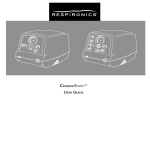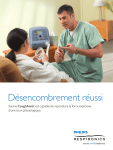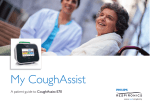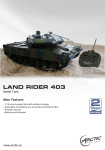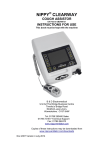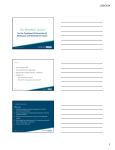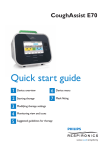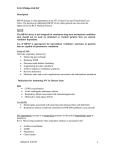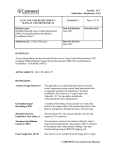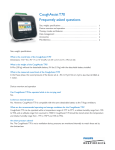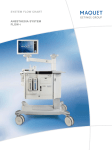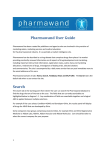Download CA protocol.pub
Transcript
CoughAssist T70 Suggested protocol Please refer to the CoughAssist T70 user manual for complete product descriptions, including indications and contraindications for use. Once it has been determined that the CoughAssist treatment is clinically appropriate, the following may be used as a suggested protocol. Please review the entire protocol before initiating therapy. This protocol is not intended as a substitute for advice from a licensed physician or other healthcare professional, and the prescription issued by the patient’s physician should be followed. Indications For use with patients unable to cough or clear secretions effectively due to reduced peak expiratory flow. • Those who might benefit from the use of the CoughAssist include patients with an ineffective cough due to muscular dystrophy, myasthenia gravis, poliomyelitis, or other neurologic disorder with some paralysis of the respiratory muscles, such as spinal cord injury. It may also be used to treat ineffective cough due to other bronchopulmonary diseases, such as emphysema, cystic fibrosis, and bronchiectasis. It is effective for both trached and noninvasively ventilated patients. • In pediatric patients who are able to perform a reproducible forced expiratory flow maneuver, a value less than 50% of predicted is an indication for CoughAssist therapy. PCF values > 270 LPM1 have been established as the minimum level necessary to clear secretions in adults, but values for small children have yet to be validated and may be lower than the values for adults.2 Contraindications • • • Any patient with a history of bullous emphysema Susceptibility to pneumothorax or pneumomediastinum Recent barotraumas The above contraindications should be carefully considered before use. Warnings and cautions Refer to the CoughAssist T70 user manual. Patient preparation The CoughAssist T70 should be carefully introduced to the patient. If treating a pediatric patient, a parent or trusted caregiver should be involved, if possible. Allow the patient to become familiar with the mask, especially if they are unaccustomed to positive pressure therapy. Page 2 Implementation of CoughAssist T70 • Attach the CoughAssist patient circuit to the CoughAssist output, including a bacterial/viral filter, smoothbore tubing, and an appropriate interface (mask, mouthpiece, or trach adapter). If a mask is used, it should be of appropriate size to provide a tight seal. When used with a trach, attaching directly to an inline suction catheter allows for easy removal of secretions from the top of the trach. • Explain principles of the CoughAssist T70 to the patient and the caregiver–deep inflation of the lungs followed by a forced exhalation of air aimed at removing secretions located in the central airways. Explain that the patient should relax so the air delivered by the CoughAssist T70 slowly expands the lung and chest wall. After the deep breath is delivered, the exhalation phase will begin immediately. Instruct the patient to exhale fully during the exhalation phase.2 Settings and modes Manual mode This mode may be used for initial acclimation to the CoughAssist T70 and for titrating pressures and adjusting times prior to using the Automatic mode. • Power on the CoughAssist T70 and select the “Settings” button. Select Manual mode on the display. Set the initial device pressures. Begin with inspiratory pressures between +10 and +15 cm H2O and expiratory pressures of between –10 and –15 cm H2O to allow an introduction/acclimation to the device.3 Set device inhale flow to the low setting. Press the “Finish” button. • Press the “Therapy” button to start treatment. Attach the appropriate interface to the patient. Start with a single cough cycle to allow for acclimation to the device. A cough cycle is one inspiration, one expiration, and then a pause, if needed. Move the Manual switch to the inhale position and hold for 2 to 3 seconds. Immediately move the Manual switch to the exhale position and hold for 1 to 2 seconds, then release the switch to the neutral position. Verify patient comfort and tolerance of the maneuver. Adjust timing to coordinate with the patient’s breath rate and rhythm.4 • Continue with several cough cycles, 3 to 6 for pediatric patients and 4 to 6 for adults, in a session. If desired, a pause of 2 to 5 seconds between cough cycles may be used. Confirm continued tolerance of the maneuvers. A rest period of 30 seconds may be used before the session is repeated. Return the patient to his/her normal oxygen or ventilation settings during the rest period, if necessary. Perform at least 3 to 5 sessions for pediatric patients and 4 to 6 sessions for adults for each treatment.2,4 • Gradually increase the inspiratory and expiratory pressures. Adjust inhale flow, if needed, for patient comfort. Continually monitor the patient for comfort and tolerance. Positive pressure levels can be established by evaluation of chest wall expansion and auscultation for bilateral air entry.4 The displayed tidal volumes may be used to titrate inspiratory pressure levels to achieve adequate inspired volumes. The displayed values for peak cough flows may also be used to titrate expiratory pressure levels and to coach patient effort. Inspiratory and expiratory pressures of up to +/- 40 cm H2O show the best results and are generally well tolerated.2 Page 2 Page 3 • Whenever possible, solicit feedback from the patient regarding pressures and inspiratory and expiratory times. For example, a gesture of up or down can be used to indicate whether to increase or decrease pressures or times. • Subsequent treatment sessions can be initiated at previously established pressures, times and flow rates. These settings may also be entered as the presets for use with the Automatic mode. Automatic mode Automatic mode provides a timing feature that will automatically trigger to inspiration and cycle to expiration instead of manually moving the switch. Inhale and exhale times entered into the device will replace manually moving the switch. Cough-Trak is a feature in the Automatic mode that will synchronize inhalation with patient effort. • Select Automatic mode on the display. Select the Cough-Trak On/Off setting. If pressures, times, and flows were titrated using the Manual method, use those final values as starting values for the Automatic mode. If titrating in Automatic mode, use the same initial settings as the Manual mode and adjust for patient comfort and tolerance. If Cough-Trak is enabled, the pause time is determined by the patient trigger. • Attach the patient interface to the patient and press the “Therapy” button. Therapy will start automatically if Cough-Trak is turned off. If Cough-Trak is enabled, therapy will start as soon as the patient initiates a breath. • The treatment can be temporarily suspended at any time by pressing the “Standby” key and returning the patient to his/her normal oxygen or ventilation settings. • Adjustments to therapy can be made from the “Settings” screen while in “Standby” or “Therapy” mode. Treatment length and process • A cough cycle is composed of one inspiration, expiration, and pause phase. A standard sequence consists of 3 to 6 consecutive cough cycles for pediatric patients and 4 to 6 consecutive cough cycles for adults, followed by a rest period of 30 seconds. Patients should be returned to their normal oxygen or ventilator settings during the rest period, if necessary. Sequences can be repeated 3 to 6 times if needed to clear secretions.2,4 • Suction equipment should be available and visible secretions should be removed via suction from mouth, tracheostomy tube, or tubing, as needed.4 • A properly applied abdominal thrust or lower chest compression, coordinated with the exsufflation phase of the cough cycle, can enhance peak cough flows and secretion clearance.5 Page 3 Page 4 Use with a tracheostomy Higher exhale pressures may be required to overcome the increased resistance of a tracheostomy or endotracheal tube. If the tracheostomy tube is cuffed, it is advised to have the cuff inflated for the CoughAssist T70 treatment and to use a means for trapping any secretions that may potentially accumulate in the treatment circuit. Standard water traps, sputum traps, or extension tubing with corrugated inner walls can serve well for this purpose. NOTE: The FDA defines pediatric in subgroups as follows: newborn—from birth to 1 month of age; infant—greater than 1 month to 2 years of age; child—greater than 2 to 12 years of age; adolescent— greater than 12 to 21 years of age. 1 Bach JR, Ishikawa Y, Kim H. Prevention of pulmonary morbidity for patients with Duchenne Muscular Dystrophy. Chest 1997;112:1024-1028. 2 Fauroux B. et al. Physiological benefits of mechanical insufflation-exsufflation in children with neuromuscular diseases. Chest 2008;133:161-168. 3 CoughAssist Users Guide. J.H. Emerson Co. 4 Miske, Laura J., et al. Use of the mechanical in-exsufflator in pediatric patients with neuromuscular disease and impaired cough. Chest 2004;125:1406-1412. 5 Bach JR. Mechanical insufflation-exsufflation comparison of peak expiratory flow with manually assisted and unassisted coughing techniques. Chest 1993;104:1553-1562. edoc JH 10.19.12 MCI 4105308 Page 4





